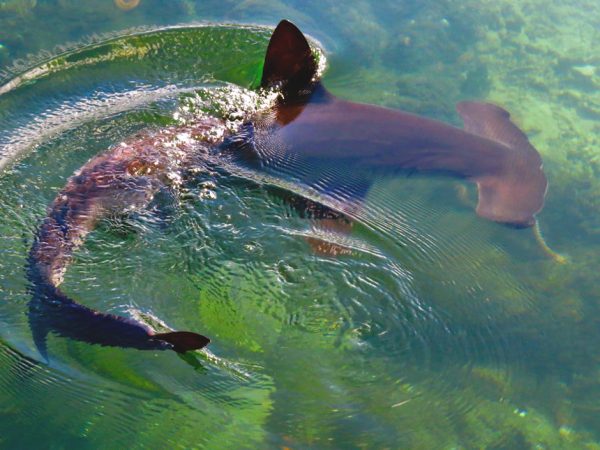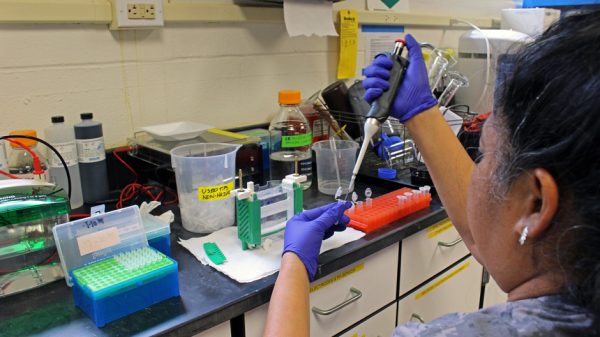Research and Education at the Hawaii Institute of Marine Biology
 Coral field research. (Credit: ©2019 Hawaii Institute of Marine Biology)
Coral field research. (Credit: ©2019 Hawaii Institute of Marine Biology)An independent research facility within the School of Ocean Earth Science and Technology (SOEST) at the University of Hawaiʻi at Mānoa, the Hawaiʻi Institute of Marine Biology (HIMB) has multidisciplinary research and education in tropical marine biology at the heart of its mission. HIMB is also a world leader in applying new technologies to conservation research into Hawaiʻi’s stunning biodiversity.
Dr. Judith D. Lemus, HIMB’s interim director and the co-director of the University of Hawaiʻi at Manoa’s graduate program in marine biology, spoke to EM about HIMB.
“HIMB is a partner in the Alliance for Coastal Technologies, which supports development and evaluation of technologies for coastal environments,” explains Dr. Lemus. “HIMB helps to identify, evaluate, and improve emerging technologies like sensors and automated arrays that can be used for coastal water quality monitoring.”
There is also a long-term statewide coral reef monitoring and assessment program (CRAMP) that has been ongoing since 1998.
“The network consists of over 30 long-term coral reef monitoring sites and associated data base, and includes state-wide habitat spatial mapping and rapid quantitative assessments,” Dr. Lemus describes. “One important area of interest is on developing a better understanding of the ecology of Hawaiian coral reefs under climate change and as they relate to other geographic areas using these tools.”
New technologies at HIMB
Several emerging areas of research at HIMB are using drones and autonomous vehicles to explore the world beneath the water’s surface.

Using drone technology in the field. (Credit: ©2019 Hawaii Institute of Marine Biology)
“Drones and autonomous vehicles are being used by research teams studying coral reefs, marine mammals, and sharks,” states Dr. Lemus. “The Madin Lab is using UAVs and photogrammetry to provide measurement estimates of corals in 3D. The Marine Mammal Research Program is using drones to survey the body condition and behaviors of humpback whales in Hawaii, and UAV photogrammetry to develop a method to rapidly assess delphinid population age structure that can provide an assessment of population growth and survival rates.”
The Shark Lab is also using tags and telemetry to test the use of animal-borne tags for collecting oceanographic data such as oxygen, temperature, and ambient light. Tags also provide information about migration and movement patterns of sharks.

A hammerhead. (Credit: ©2019 Hawaii Institute of Marine Biology)
The HIMB MakerLab is another hotspot for new technologies that educators can put to work.
“The MakerLab is a makespace-style science laboratory and design workshop that was created for in-service and pre-service teachers, and other undergraduates, to explore science, engineering, and design practices so they are better prepared to teach scientific investigation and authentic inquiry in the classroom,” comments Dr. Lemus. “We are currently funded by NSF to guide pre-service teachers in scientific questioning, design, tinkering, and investigation. MakerLab is also used by other visiting groups and even researchers who need a flexible space to design or conduct projects.”

Working in the Maker Lab. (Credit: ©2019 Hawaii Institute of Marine Biology)
Research and educational facilities at HIMB
HIMB offers top-notch facilities for outside researchers.
“Visiting researchers are sponsored by one of our faculty and generally work in the research laboratory of that faculty member,” remarks Dr. Lemus. “They may also utilize some of our other shared research facilities such as seawater tanks or the genomics core facility.”
HIMB also hosts a number of different educational programs for students, as this is a key area for the Institute.
“Education is a very important part of our mission and HIMB offers educational programs for students from grade 4 to post-graduate,” Dr. Lemus adds. “Our Community Education Program (CEP) provides both tours and educational programs for visiting classes, community groups, and families. The High School Science Inquiry program offers field trip experiences and hands-on laboratories for high school students and classes. Undergraduate students receive research training through internships in individual labs, field courses, or through MakerLab.”
Although there are no formal citizen science initiatives at HIMB, there are multiple ways for the public to get involved with HIMB.

Participants in a HIMB Community Education Program. (Credit: ©2019 Hawaii Institute of Marine Biology)
“Public education is generally run through the CEP, but many individual labs might offer opportunities for members of the public to get involved in science research,” advises Dr. Lemus. “One current project, led by the Coral Reef Ecology Lab, is the development of coral health color cards that recreational swimmers, snorkelers, and divers can use to assess and report on the health of the corals that they encounter. HIMB is also very interested in the integration of science and art, and we have developed many collaborations with artists, from artists-in-residence to short-term visiting artists, to science-art exhibits (one ran recently at a local gallery).”
Dr. Lemus and the team at HIMB hopes that readers get a sense of the unique range of opportunities that their lab offers—scientific and cultural.
“HIMB is one of the only marine labs in the world with well-provisioned modern science research facilities and access to a living coral reef preserve within 50 feet of the lab,” comments Dr. Lemus. “Also, as a unique place-based research and educational resource in the Pacific, we value local culture, diversity, and Hawaiian knowledge, and strive to base our work in both Western science and Indigenous ways of knowing.”

A confocal image of coral. (Credit: ©2019 Hawaii Institute of Marine Biology)




0 comments